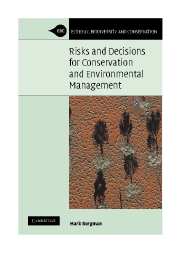Book contents
- Frontmatter
- Contents
- Preface
- Acknowledgments
- 1 Values, history and perception
- 2 Kinds of uncertainty
- 3 Conventions and the risk management cycle
- 4 Experts, stakeholders and elicitation
- 5 Conceptual models and hazard assessment
- 6 Risk ranking
- 7 Ecotoxicology
- 8 Logic trees and decisions
- 9 Interval arithmetic
- 10 Monte Carlo
- 11 Inference, decisions, monitoring and updating
- 12 Decisions and risk management
- Glossary
- References
- Index
5 - Conceptual models and hazard assessment
Published online by Cambridge University Press: 03 December 2009
- Frontmatter
- Contents
- Preface
- Acknowledgments
- 1 Values, history and perception
- 2 Kinds of uncertainty
- 3 Conventions and the risk management cycle
- 4 Experts, stakeholders and elicitation
- 5 Conceptual models and hazard assessment
- 6 Risk ranking
- 7 Ecotoxicology
- 8 Logic trees and decisions
- 9 Interval arithmetic
- 10 Monte Carlo
- 11 Inference, decisions, monitoring and updating
- 12 Decisions and risk management
- Glossary
- References
- Index
Summary
Hazard assessment attempts to answer the question. ‘What can go wrong?’.
A hazard is a situation that in a particular circumstance could lead to harm (Royal Society 1983). Hazard identification is the process of creating an exhaustive list of hazards. It involves documenting all events with unwanted outcomes that may result from natural circumstances, a proposal or human activity. Hazard assessment estimates the consequences of those hazards, if they were to occur. It relies on understanding cause and effect.
This chapter outlines the role of conceptual models in summarizing ideas and providing a platform for identifying alternative management options. It describes several hazard identification methods developed and applied mostly in engineering contexts, but which have much broader utility. It evaluates their strengths and weaknesses and provides some examples of environmental applications.
Conceptual models
All steps in a risk assessment, including hazard identification and assessment, depend on a decent conceptual model. Models are abstractions. They represent how we think the world works. We build models to answer specific questions, to assist us in making decisions.
As was outlined in Chapter 3, the purpose of a model determines its structure and limits. The kind of model and its complexity are a compromise between the questions and available time, expertise and knowledge. It is the responsibility of the person who builds a model to communicate the full range of uncertainties and assumptions.
- Type
- Chapter
- Information
- Publisher: Cambridge University PressPrint publication year: 2005



